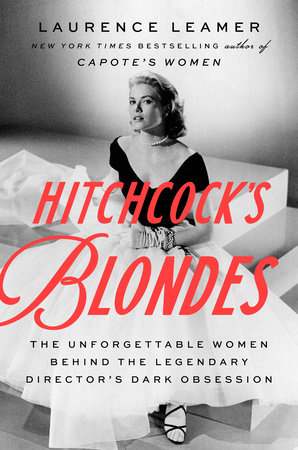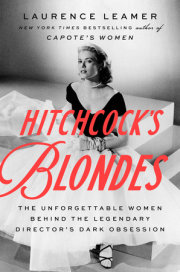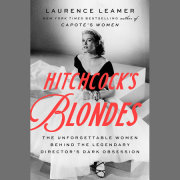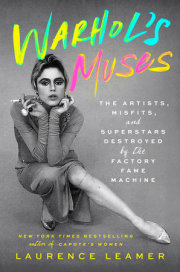Chapter 1A Fairy TaleTippi Hedren was not afraid of birds. In her dressing room, the thirty-two-year-old actress had a raven named Buddy. Hedren was costarring in
The Birds, Alfred Hitchcock's film set in the Northern California seaside town of Bodega Bay, whose avian population was slowly, strangely turning on the residents and attacking them.
Buddy was not like those birds. He pranced around, messing with Hedren's makeup, amusing her endlessly. Buddy was her one true friend on the set, so much so that she put a sign on her dressing room door saying "Buddy and Tippi."
As far as Hedren was concerned, her Hollywood story had begun as a fairy tale. One morning Hitchcock saw the blond model in an ad for a diet drink on television; the renowned director was so enraptured that he signed her to play the female lead in his next film. At her age, Hedren's days as a top model were over. She knew how lucky she was that Hitchcock had come forward. Hedren knew almost nothing about acting, but Hitchcock took her and molded her into the image he desired.
That was all wonderful, but strange things started happening once The Birds began shooting. Hitchcock warned the other men involved in the production to stay away from Hedren. She was often alone on set and increasingly isolated. A single mother, Hedren was lonely and missing her child during the long shooting days. One day, she said Hitchcock tried to embrace her in the chauffeur-driven car in which they were traveling.
As Hedren waited to be called to the set, the assistant director, James H. Brown, entered her dressing room. He appeared worried.
"What's the matter with you?" Hedren asked.
"We can't use the mechanical birds," he said, the words barely audible.
"Uh, well, what are we going to use?" Hedren asked, though the answer should have been obvious.
"The mechanical birds don't work, and we have to use real ones."
This startled Hedren, and it took her a while to compose herself.
Hedren had already suffered through the birds attacking her and various schoolchildren as they ran down the street in Bodega Bay. But that was nothing like the scores of birds set to go after Hedren this morning as she opened the attic door.
In Hitchcock's four decades of filmmaking, there had never been a scene like this-two minutes so dangerous and, in the director's mind, so
pleasurable to an audience seeking vicarious thrills. Hedren knew the scene had to be shot. As apprehensive as she was, what choice did she have but to leave her dressing room and walk out on the set?
Hedren saw that the crew had built a cage attached to the attic door. The trainers inside wore long, thick leather gloves to protect themselves. Beside them sat four good-sized boxes full of ravens and gulls.
As Hedren stood before the closed door, Hitchcock yelled, "Action!" She opened the door, and the handlers started hurling live birds at her. The flapping of feathers, the screams, the squawks-it was terrifying for everyone on set. If this had gone on for a few takes, that would have been one thing. But Hitchcock insisted on continuing until he got every shot he believed he needed.
Days passed.
On the fifth straight day of shooting this scene, to get the most intimate perspectives of the attacking birds, the crew attached elastic bands to Hedren and tied the feet of several birds to the bands.
"Action," Hitchcock shouted. The birds had been trained to claw at a person, and they did their job well. Hedren already had bruises over much of her body from days of working with the creatures, but this was a whole new level of hurt. The assault continued until the middle of the afternoon, when one of the birds pecked near Hedren's eyes. An inch or two closer, and she might have lost her sight.
Hedren could take no more. "I'm finished," she said. The handlers untied the birds and put them in the cartons. Hedren lay on the floor of the set, crying. Silence fell. When she finally looked up, everyone was gone, and she was alone on the vast soundstage. She did not know whether her colleagues were ashamed or just glad the business was over.
When she managed to pull herself together enough to get up and retreat to her dressing room, her raven, Buddy, was there to greet her.
Chapter 2A Naughty BoyWhen twenty-five-year-old Alfred Hitchcock arrived in Berlin in the fall of 1924, he was shocked. Not by one thing; by
everything.
Nothing, it seemed, was verboten in Berlin. Hundreds of nightclubs and bars featured every kind of sexuality, including heterosexual sex, homosexuality, lesbianism, transsexuality, and nudity. In certain corners of this world, it was possible to see the most intimate act between two humans (or maybe more) performed in public like a piece of theater. It was like nothing the cloistered young art director had ever seen back home in England.
Hitchcock was a voyeur, and he had come to the right place at the right time. In Weimar-era Berlin, anything went as bourgeois German society expired. Hitchcock liked to stand outside the circle of life, watching everything that happened within its boundaries. It made sense that his preferred position was behind a camera-observing everything, but at a safe distance.
The young filmmaker had a plain, abrupt face obscured by jowls. At his peak, in later years, he would weigh over three hundred pounds. His size was a burden he could not shirk. But as a young man he was merely portly, and he cared deeply about how he looked and the way he came across to others.
Hitchcock was a natty dresser; he wore carefully selected clothes that shrouded his size and drew attention away from his weight. To an outside observer he appeared a worldly sort but, by his admission, he was at that time a complete rube. In fact, he did not even know how the sex act was performed until he was twenty-three. If he had been less shy at his Jesuit school, some of the boys might have taught him the facts of life in the schoolyard, but he had been friendless.
Berlin was a revelation.
One evening in the German capital, Hitchcock went with two of his associates to a nightclub where men were dancing with each other, a scene straight out of Christopher Isherwood's quasi-autobiographical
The Berlin Stories, the basis for the musical
Cabaret. It must have been confusing, disturbing, and possibly alluring for a man of Hitchcock's secret proclivities. He said later that if he had not married his fiancée, Alma Reville, he might have become a "poof." But to a fearful Catholic like Hitchcock, the idea that he would act on his temptation was unthinkable. He boarded up these closeted feelings and walked ahead, never veering from the narrow and straight.
The adventure was not over. The group later met two German women at the nightclub, one in her late teens, the other around thirty. Hitchcock said the women offered to drive them home, but took the group to a hotel room instead. A savvier man would have recognized the situation for what it was, but Hitchcock's naivete again seems to have prevailed.
Once in the hotel, the women attempted to woo Hitchcock into having sex. He was shocked-titillated, yes, but also frightened. No way was he going to lose his virginity to a woman of dubious repute as his acquaintances watched, gauging his performance. As Hitchcock knew too well, fear-real fear-was not only apprehension that some evil menace would come out of the fog to bludgeon one to death. It was something like this evening's event. It was being asked to perform an act he had never performed before, that he did not know if he could do or even
wanted to do-with an audience no less! But one that he must do if he wanted to be called a man.
Hitchcock kept saying, "Nein, nein," his words so definitive that the women gave up, got into bed, and made love to each other. It was a spectacle worth observing, and one of the young women in the group pulled out her glasses so she could watch in detail.
Hitchcock did not need glasses.
Hitchcock never said whether the German women were blondes; if they were, he would have enjoyed the sexual spectacle even more. To Hitchcock, blond women were the epitome of female beauty, and he fixated on them. Blondes, to his eye, were not just some quirk of genetic nature; they were superior beings, Valkyries with coolness as pure as the Arctic snows encasing fiery inner beings that, to the right man, opened up in lusty wantonness.
Blondes' natural home was Scandinavia and other nations around the Baltic Sea, a region where intense sunlight came with a short, bright summer-a sun-drenched season that was gone scarcely as soon as it arrived. The blondes seen in his native London, however, were almost always the product of chemistry and artifice.
Hitchcock looked at the world of women with geographic absolutism. "I more or less base my idea of sexuality on northern European women," he said. "I think the northern Germans, the Scandinavians, and the English are much sexier, although they don't look it, than those farther south-the Spanish, the Italians."
Hitchcock knew that an inordinate amount of his success lay with the women he chose to play in his films. As a young director in London, he often watched films at newly built movie palaces as large as cathedrals. To achieve success, he would have to fill those seats again and again. As he looked across the theaters, he saw that "women form three-quarters of the average cinema audience." Since they often convinced their husbands and lovers which movies they should attend, Hitchcock cannily realized that his heroines "must be fashioned to please women rather than men... Therefore, no actress can be a good commercial proposition as a film heroine unless she pleases her own sex."
Hitchcock was brutally realistic about actresses. Unlike the stage, where a middle-aged actress could masquerade as an ingenue, the camera did not flinch from the harshest truths. Even the loveliest of young women likely lasted no more than a dozen years before the shadows of age arrived and she was shuttled off the set. If the women in the audience did not like her, she was probably gone in three or four years.
Even if the young woman had everything-beauty, amiability, charm-it might not be enough for Hitchcock. "I have to consider whether my potential heroine is sensitive to direction," Hitchcock wrote in 1931. "In other words, whether she is the kind of girl I can mold into the heroine of my imagination." Hitchcock spent his career doing just that.
Creating a Pygmalion appears a glorious thing when it is Professor Henry Higgins transforming the street waif Eliza Doolittle into a beauty who can masquerade as a princess in
My Fair Lady. But when that journey is about sexual power-a gentleman not lusting after his ideal in his book-lined study, but actually creating her in the flesh-the dark side of such a pursuit is revealed. And Hitchcock did it again and again in his films, getting off on it every time. And his audiences got off on it too.
Hitchcock took what in real life would likely have been considered a sick fixation on the icy, unattainable blond woman and turned it into a central part of his artistic dream. In time, Hitchcock's fantasies about the actresses who starred in his films consumed much of his creative energy-and ultimately defined a large part of his legacy.
Hitchcock made films in a Hollywood in which the sexual exploitation of women was a fundamental part of the culture. Actresses learned if they wanted to succeed, they first must give an Academy Award-level performance on the casting couch. Women were shuttled in and out of back rooms and hotel suites as if their only purpose in life was the pleasuring of men.
In this world, Hitchcock was an anomaly. As egregious as his conduct sometimes was-he gawped, he cajoled, he suggested-he apparently never consummated a relationship with any of the actresses in his films. That did not mean Hitchcock was disinterested in sex. He was obsessed with it. Like a street urchin standing at the window of a candy store, his nose pressed against the plate glass, he could not taste any of the sweet delights that lay within.
"It is clear to me Hitchcock had Asperger's syndrome, now included in autism spectrum disorder," says Dr. Heath King, a psychoanalyst who taught a course on masterpieces of American film at Yale. "He was a loner, an ogler, who sublimated his lack of sex into a voyeuristic cinema technique. The anxiety and fear he evoked in his films were a projection of his own inner anxiety and fear of an actual personal encounter when he was not in control.
"Aspergers are some of the most intelligent and accomplished people anywhere, but in their profound need to speak the truth, they can be curt and unfeeling, totally unaware or dismissive of the effects their actions have on people. This lack of empathy was integral to Hitchcock's enormous gifts."
As Hitchcock became one of the most famous and celebrated directors of the twentieth century, he was fixated on the blond actresses who starred in many of his classic films. The director did not care if these women wore wigs, got their hair coloring out of a bottle, or were the rarest human species-natural blondes-as long as they shone with golden veneers on camera.
The director had no interest in squandering his films on saintlike women, no
The Bells of St. Mary's for him.
His blond actresses played soiled women: thieves, adulteresses, murderers, murderers' accomplices, sluts, and vapid socialites. He purified these women in his films by making them suffer until he redeemed them.
June Howard-Tripp was the first blond actress to experience the Hitchcock touch. Known simply as "June" by the London West End theatrical audiences that adored the diminutive musical comedienne, June had never had a significant role in a film when approached to costar in Hitchcock's 1927 silent film
The Lodger. The director so overworked her in one scene that she almost died.
Madeleine Carroll was an emerging British star when Hitchcock signed her to costar in
The 39 Steps (1935). In the film, Carroll is handcuffed to her costar, Robert Donat, and chased through the bogs of Scotland, leaving bruises all over her body.
The Swedish-born Ingrid Bergman was the biggest star in America when she starred in
Notorious (1946). Playing the wildly promiscuous daughter of a convicted Nazi spy, she seeks to redeem herself by marrying a prominent Nazi and spying on him.
Grace Kelly would one day be the number-one star too. She was near the beginning of her short-lived career when she costarred in
Dial M for Murder (1954). In it, Kelly is an adulteress whose husband seeks to murder her.
In
North by Northwest (1959), Eva Marie Saint is an undercover American agent sleeping with one of her country's enemies in an attempt to learn his secrets. She ends up being chased onto the face of Mt. Rushmore, where she and her costar Cary Grant almost fall to their deaths.
None of Hitchcock’s blonde actresses suffered as much as Tippi Hedren, who was attacked by swarms of enraged birds in
The Birds (1963). If that was not humiliation enough, in the director’s next film
Marnie (1964), she is raped on her honeymoon.
Most of these characters made it through to make themselves whole, but two did not. Hitchcock cast Kim Novak in dual roles in
Vertigo (1958). An accomplice in a murder in love with a man who spurns her, she throws herself off a tower.
Janet Leigh’s character in
Psycho (1960) suffers an equally ugly fate. Having stolen from her employer, she decides to face up to her crime. Before she can do so, she is knifed to death in the shower in film’s most memorable murder scene.
These eight actresses who starred in fourteen of Hitchcock’s most notable films knew the truths of his art as well as anyone. Whether their characters lived or died, they went through intense experiences with Hitchcock, sometimes joyous and playful, other times ugly and demeaning, but creating classic films.
As much as Hitchcock sought to control these actresses, critic Camille Paglia writes, "misogyny is a hopelessly simplistic and reductive term for the passionately conflicted attitude of major male artists toward women." As these actresses made memorable films with Hitchcock, he projected his complicated, tortured attitude toward women onto the screen. He recorded what Paglia calls "the agonized complexity of men’s relationship to women—a roiling mass of admiration, longing, neediness and desperation."
Many men fear the siren call of the female, leading them to a dark jungle from which there is no escape. That fundamental fear of women is an omnipresent reality across cultures, nations, and eras, no less true because it is so often denied.
Copyright © 2023 by Laurence Leamer. All rights reserved. No part of this excerpt may be reproduced or reprinted without permission in writing from the publisher.








